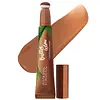What's inside
What's inside
 Key Ingredients
Key Ingredients

 Benefits
Benefits

 Concerns
Concerns

 Ingredients Side-by-side
Ingredients Side-by-side

Hydrogenated Polyisobutene
EmollientTrimethylolpropane Triisostearate
EmollientPolyethylene
AbrasiveSqualane
EmollientMicrocrystalline Wax
Emulsion StabilisingPolymethylsilsesquioxane
Mica
Cosmetic ColorantSilica Dimethyl Silylate
EmollientHydrogenated Styrene/Isoprene Copolymer
Pentaerythrityl Tetra-Di-T-Butyl Hydroxyhydrocinnamate
AntioxidantSilica
AbrasiveTocopherol
AntioxidantEthyl Vanillin
MaskingDicalcium Phosphate
AbrasiveCI 77891
Cosmetic ColorantIron Oxides
Hydrogenated Polyisobutene, Trimethylolpropane Triisostearate, Polyethylene, Squalane, Microcrystalline Wax, Polymethylsilsesquioxane, Mica, Silica Dimethyl Silylate, Hydrogenated Styrene/Isoprene Copolymer, Pentaerythrityl Tetra-Di-T-Butyl Hydroxyhydrocinnamate, Silica, Tocopherol, Ethyl Vanillin, Dicalcium Phosphate, CI 77891, Iron Oxides
Water
Skin ConditioningCyclopentasiloxane
EmollientIsododecane
EmollientSilica
AbrasiveTriethylhexanoin
MaskingGlycerin
HumectantCetyl PEG/PPG-10/1 Dimethicone
EmulsifyingPolyglyceryl-4 Diisostearate/Polyhydroxystearate/Sebacate
EmulsifyingQuaternium-90 Bentonite
Sodium Chloride
MaskingPropylene Carbonate
SolventMica
Cosmetic ColorantTriethoxycaprylylsilane
Phenoxyethanol
PreservativeParfum
MaskingCaprylyl Glycol
EmollientTribehenin
EmollientAstrocaryum Murumuru Seed Butter
EmollientEthylhexylglycerin
Skin ConditioningHexylene Glycol
EmulsifyingHydrogenated Starch Hydrolysate
HumectantMaltooligosyl Glucoside
Skin ConditioningQuartz
AbrasiveAstrocaryum Tucuma Seed Butter
EmollientTheobroma Grandiflorum Seed Butter
Skin ConditioningAluminum Hydroxide
EmollientTocopherol
AntioxidantLecithin
EmollientAscorbyl Palmitate
AntioxidantGlyceryl Stearate
EmollientGlyceryl Oleate
EmollientCitric Acid
BufferingCitral
PerfumingIron Oxides
CI 77891
Cosmetic ColorantWater, Cyclopentasiloxane, Isododecane, Silica, Triethylhexanoin, Glycerin, Cetyl PEG/PPG-10/1 Dimethicone, Polyglyceryl-4 Diisostearate/Polyhydroxystearate/Sebacate, Quaternium-90 Bentonite, Sodium Chloride, Propylene Carbonate, Mica, Triethoxycaprylylsilane, Phenoxyethanol, Parfum, Caprylyl Glycol, Tribehenin, Astrocaryum Murumuru Seed Butter, Ethylhexylglycerin, Hexylene Glycol, Hydrogenated Starch Hydrolysate, Maltooligosyl Glucoside, Quartz, Astrocaryum Tucuma Seed Butter, Theobroma Grandiflorum Seed Butter, Aluminum Hydroxide, Tocopherol, Lecithin, Ascorbyl Palmitate, Glyceryl Stearate, Glyceryl Oleate, Citric Acid, Citral, Iron Oxides, CI 77891
Ingredients Explained
These ingredients are found in both products.
Ingredients higher up in an ingredient list are typically present in a larger amount.
Ci 77891 is a white pigment from Titanium dioxide. It is naturally found in minerals such as rutile and ilmenite.
It's main function is to add a white color to cosmetics. It can also be mixed with other colors to create different shades.
Ci 77891 is commonly found in sunscreens due to its ability to block UV rays.
Learn more about CI 77891Mica is a naturally occurring mineral used to add shimmer and color in cosmetics. It can also help improve the texture of a product or give it an opaque, white/silver color.
Serecite is the name for very fine but ragged grains of mica.
This ingredient is often coated with metal oxides like titanium dioxide. Trace amounts of heavy metals may be found in mica, but these metals are not harmful in our personal products.
Mica has been used since prehistoric times throughout the world. Ancient Egyptian, Indian, Greek, Roman, Aztec, and Chinese civilizations have used mica.
Learn more about MicaSilica, also known as silicon dioxide, is a naturally occurring mineral. It is used as a fine, spherical, and porous powder in cosmetics.
Though it has exfoliant properties, the function of silica varies depending on the product.
The unique structure of silica enhances the spreadability and adds smoothness, making it a great texture enhancer.
It is also used as an active carrier, emulsifier, and mattifier due to its ability to absorb excess oil.
In some products, tiny microneedles called spicules are made from silica or hydrolyzed sponge. When you rub them in, they lightly polish away dead skin layers and enhance the penetration of active ingredients.
Learn more about SilicaTocopherol (also known as Vitamin E) is a common antioxidant used to help protect the skin from free-radicals and strengthen the skin barrier. It's also fat soluble - this means our skin is great at absorbing it.
Vitamin E also helps keep your natural skin lipids healthy. Your lipid skin barrier naturally consists of lipids, ceramides, and fatty acids. Vitamin E offers extra protection for your skin’s lipid barrier, keeping your skin healthy and nourished.
Another benefit is a bit of UV protection. Vitamin E helps reduce the damage caused by UVB rays. (It should not replace your sunscreen). Combining it with Vitamin C can decrease sunburned cells and hyperpigmentation after UV exposure.
You might have noticed Vitamin E + C often paired together. This is because it is great at stabilizing Vitamin C. Using the two together helps increase the effectiveness of both ingredients.
There are often claims that Vitamin E can reduce/prevent scarring, but these claims haven't been confirmed by scientific research.
Learn more about TocopherolThis ingredient is a combination of red, black, and yellow iron oxide pigments. This combination of colors is usually found in foundation, because it results in a "skin" color.